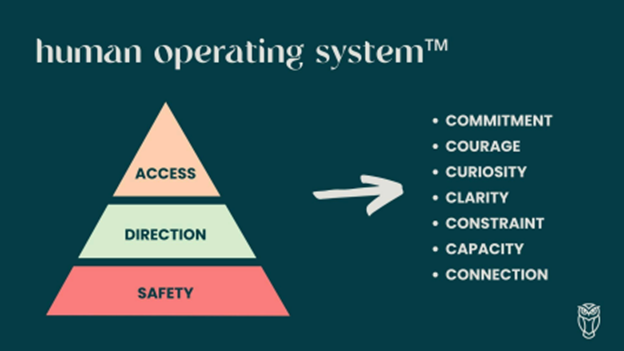COACHES CORNER
| Print this Article |

It’s More Than Being “Too Busy”: A Love Story About Burnout and Identity
By Lindsay Troxell
This isn’t your typical article about burnout. It’s a love story.
The First Time I Experienced Burnout
I never dreamed of selling life insurance. I had attended college for entrepreneurship and was supposed to take over the family's residential real estate business. But that didn’t happen, and here I was, waking up every day with a crushing sense of dread. Reflecting, I was burnt out—I just didn’t know it at the time. I’m actually grateful it only took me seven months to realize I wasn’t meant to be a financial advisor.
For some, it can take years, even decades, to understand why they feel so chronically stuck. For me, it was crystal clear. I was meant to be a business coach, not an advisor. The part of my day I craved was when I would help my peers improve what they were doing—not designing financial plans. For the first time, I felt like I knew who I was—or at least who I wanted to become. And so the journey began.
The Buildup
For the next 15 years, I worked with thousands of advisors and advisory firms of all shapes and sizes. I bounced between institutions every few years. Whether for a broker-dealer, a custodian, or an investment manager—I loved being a business consultant. I was good at it. However, my experience as an employee always followed a similar path.
Excitement gave way to internal friction, which in turn led to emotional exhaustion, followed by cynicism, and ultimately disengagement.1 I’d burn out. Again and again.
It didn’t matter where I was. I loved being a business coach, but something was off.
When COVID hit, I was on the road 85% of the year, crisscrossing the country at the pleasure of our sales organization. I welcomed the relief I thought would come from being grounded for the first time in over a decade. I was exhausted, but I could finally take a break. I started practicing what I preach—managing my 8 Dimensions of Self™. My creativity was cracking open.

And then in April 2021, as it has in the past, the friction came, which in turn led to emotional exhaustion, followed by cynicism, and ultimately disengagement. I was burnt out. Again.
The Research
I didn’t know it at the time, but my research on stress and subsequent introduction to the work of Christina Maslach would help me identify one of the missing links in my own burnout journey.2 I always thought burnout was simply a result of working too much, but what I came to understand was it was far more complex. Burnout happens when there's a fundamental mismatch between who you are and what your environment demands.
Maslach found there are six specific environmental mismatches that lead to burnout, and my situation checked every single box:
- Workload: Too much work/insufficient resources
- Control: Lack of autonomy/control over one's work
- Reward: Insufficient recognition, reward, or appreciation for one's work
- Community: The breakdown of a supportive community/presence of a toxic workplace culture
- Fairness: Perceived injustice in the workplace
- Values: A conflict between personal values/the values or practices of their organization
What I experienced also aligned with my research from trauma specialists like Peter Levine and neuroscientist Stephen Porges. When you're constantly trying to be someone you're not, your nervous system remains in a state of hypervigilance.3
Additionally, neurodivergent individuals like myself face additional challenges. We spend an enormous amount of energy “masking” or hiding our authentic identity in an attempt to appear neurotypical. Our social or sensory needs are often minimized or questioned, we struggle with the vagueness yet rigidity of bureaucracy, and we aren’t typically provided with access to adequate organizational tools or systems.4 It’s no wonder to me why we experience challenges when operating inside structures that weren’t built for us. And yet, it’s not understood or talked about nearly enough.
The Lightbulb Moment
This time, something was different. The lightbulb turned on. And once I saw it, I couldn’t unsee it. I was fundamentally unemployable. Not because I was incapable but because I wasn’t an employee. I was an entrepreneur. I was always going to burn out inside a corporate structure. Why? Because my identity was fundamentally misaligned with the employee role I was trying to operate within.
What I learned to love about my burnout was what it taught me. I learned to use the symptoms as signs of misalignment—a superpower that allows me to navigate my entrepreneurial journey without falling into potholes that once seemed unavoidable.
Your Nervous System-Friendly Business Coach
I knew I had to turn what I learned into a tool my clients could use. The Human Operating System™ is a three-step approach that helps create alignment and, by extension, reduce burnout.
#1: Safety: Our primitive brain was designed to survive, not thrive. If you don’t feel fundamentally safe or if your nervous system is chronically dysregulated, it’s almost impossible to dream or see the possibilities that are at your fingertips. To thrive, we need to feel safe enough to strip away industry expectations, societal pressures, and the misplaced obligations we typically carry. In my practice, we use somatic techniques such as EFT tapping, breathwork, and body scans to connect the wisdom of the body with the power of the mind. Most people, including coaches, want to skip this part—it feels unnecessary—but ultimately it’s the only necessary part in the entire process. We feel freer to dream when we now know we have our own back.
#2: Direction: Once our nervous system settles, we can access our authentic identity and desires, rather than being influenced by those inherited expectations or roles thrust upon us. A simplified version of the process involves visualizing your most fulfilled future self, creating a relationship with that person, and asking them to share their wisdom on what you should design.
#3: Access: Let’s face it, sometimes life gets crazy, and we forget what’s important to us. Because of this, we need to develop systems and tools to access the knowledge we have gained along the way. What daily habits are essential to maintaining optimal energy levels? What decisions have you made that are non-negotiable? What things commonly cause you dysregulation, and how do you respond? This information is gold, but when we get overwhelmed or busy, we tend to forget it.

The Deeper Truth
Being your own boss doesn’t preclude you from falling victim to a fundamental mismatch between who you are and what your environment demands. If you’re burning out in a business you created, that’s essential information. The question is: are you ready to listen? Because on the other side of that listening—on the other side of that burnout—there’s a version of your professional life that energizes rather than depletes you. There’s a business that feels like it was built for you, because it actually was.
That’s your love story waiting to be written.
1 Maslach, C., & Leiter, M. P. (2016). Understanding the burnout experience. World Psychiatry, 15(2).
2 Maslach, C., & Leiter, M. P. (2016). Understanding the burnout experience. World Psychiatry, 15(2).
3 Levine, P. A., “In an Unspoken Voice: How the Body Releases Trauma,” North Atlantic Books. (2010)
4 Embrace Autism, “Preventing AuDHD burnout,” Embrace Autism (2024)
Lindsay Troxell is a trauma-informed business coach who spent 20 years as a practice management consultant in financial services before launching her own firm. She specializes in helping financial advisors and entrepreneurs serving the advisor community build businesses that nourish their souls. Learn more at www.ourcoachinginitiative.com.
image credit: nelyninnell

